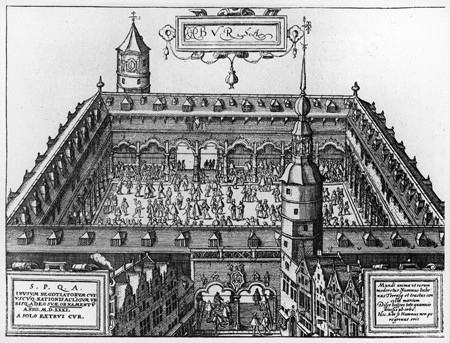The establishment of the exchange and the city’s sponsorship of Guicciardini’s text stand as important moments in the evolution of Antwerp’s self-fashioning as a worldly metropolis, a theme that is more fully explored in the first chapter of my dissertation. Antwerp’s success as an international hub during its so-called golden age depended not only on sustaining the diversity of its trading
The journal and the paintings collection of Lucas Rem (1481–1541), a south German financier, is the subject of the second chapter, “Portals.” Between 1508 and 1532 Rem resided for various lengths of time in Antwerp, where he purchased at least four landscapes by Joachim Patinir (c. 1485–1524) and an altarpiece from Quentin Massys (1466–1529). As a merchant and agent for the Welser family, Rem principally traveled the overland routes that connected regional mining operations to port cities, but he also completed several pilgrimages during his lifetime. Physically weakened by his travels, Rem frequented thermal spas to convalesce. In distinguishing qualitatively between these different journeys, my chapter ascribes visual and intellectual value to Rem’s commercial, religious, and therapeutic experiences of landscapes. Having discovered that Rem inherited an operational mine, I attempt to make both the religious folklore of mining regions and the methods of reading and assessing the significance of landscapes expressed in mining, alchemical, and balneological texts important to Rem’s reception of paintings by Antwerp artists.
The third chapter, “Orbs,” presents an analysis of the collecting practices of Portuguese merchants in Antwerp, focusing on the art collection and writings of Damião de Góis (1502–1574). While serving as treasurer of the Portuguese factory in Antwerp (1523–1545), Góis oversaw several
“Movable Walls,” the fourth chapter, treats the textile export business of English merchants, the Gresham family. In addition to
Underlying the inquiry that draws my dissertation together is an interest in exploring the incipient topologies of mobility that shaped representations of Antwerp as a city of commerce. From the experience of travel as a form of sociospatial connectivity to the transcultural communicativeness of works of art produced in Antwerp, the topologies investigated are not mathematical or geometrical, but cultural. The topological aspects of travel are not fully developed in the writings of the early modern merchant protagonists of my dissertation, but Antwerp artists gave discernible visual form to various emerging world pictures as well as to the commercial and cultural mobility that was reshaping their city. Thus one of my overarching theses is that the responsiveness of Antwerp artists to the transformational dynamics of global trade engaged foreign merchants as patrons, offering the merchants alternative ways of imagining or perceiving their experiences of both spaces and places.
Members' Research Report Archive
Rules of Engagement: Art, Commerce, and Diplomacy in Golden Age Antwerp, 1500–1576
Jessica Stevenson Stewart [University of California, Berkeley]
Robert H. and Clarice Smith Fellow, 2013–2014
An epigraph reproduced in an engraving of 1567 depicting the Antwerp Stock Exchange was originally displayed near the building’s entryway. The dedicatory inscription proclaimed that Antwerpeners “erected this structure . . . for the use of merchants of all nations and languages.” In championing the structure as an achievement of civic patronage and as the hearth of the city’s commercial cosmopolitanism, the text refers to the exchange’s incorporative function. Commissioned as an illustration for Lodovico Guicciardini’s Descrittione di tutti i Paesi Bassi (Antwerp, 1567), the propagandistic value of which had also compelled the benefaction of the Antwerp city council, the engraving promoted the exchange to foreign audiences as an architectural and a financial innovation.

Pieter van der Borcht, The New Exchange in Antwerp, 1567. Foto Marburg / Art Resource, NY